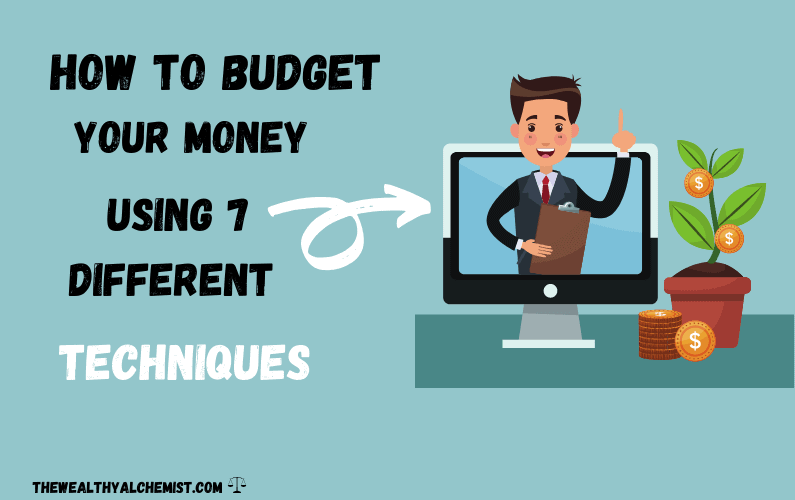
You need a budget, I need a budget we all need a budget! But the question is, how to budget your money in a way that actually works for you?
Because the fact of the matter is that budgeting can be hard…
It could be a lack of discipline on your part or just from a lack of time and mental energy. Yep.
Because some budgeting methods are uber detailed and require a lot of time to do properly. They also require a lot of mental energy to slog through the numbers.
While other budgeting techniques don’t require as much time and energy to set up.
Put plainly, there are different strokes (read: budgets) for different folks.
So if you’ve tried and failed to budget your money, why not try a different type of budget? To that end, here are several different budgeting methods to help you figure out how to budget your money best!
The first time you sat down to create a budget, you more than likely created a traditional budget. After all, it’s what most people automatically think of when thinking of a budget.
A traditional budget starts with your income and then lists out your expected expenses. So, for example, you’d list out the amount of money you expect to spend on rent, groceries, electricity, entertainment, etc., and you’d subtract it from your income.
The great thing about traditional budgets is that you create the categories. And the final product is detailed enough to let you know exactly you’re your money needs to be spent on.
The difficulty, however, is that you’re required to estimate what some of your expenses will be. Your rent obviously won’t change, but other expenses like groceries and entertainment aren’t 100% certain.
Most people get discouraged and quit budgeting after they overshoot their estimates.
If you’re going to do a traditional budget. Make sure you are realistic in your estimates. Don’t be overly optimistic about your spending habits. The best way to get a reality check on this is to review your bank statements or by signing up for Personal Capital.
Personal Capital is an app that you link to your bank account. It tracks your spending and makes it super easy to see what you’ve done with your money.
Honestly, I wouldn’t try to do a traditional budget or track my expenses without some type of program to help. And Personal Capital is my current favorite for this.
50/30/20 Budget
The 50/30/20 budget gives you only three spending categories. So, right off the bat, it’s a lot simpler than the traditional budget.
Fifty percent of your money goes towards needs: This would include your bills, food and things you have to pay to live.
Thirty percent goes towards wants, no questions asked.
The last twenty percent goes towards savings.
While this budget is super simple to write out, it doesn’t help you keep track of exactly where your money is going (Personal Capital can do that for you). It does help you save though, and also limits the unnecessary things you spend your money on.
80/20 Budget
The 80/20 budget is even simpler than the 50/30/20 budget. As you might have guessed, there are only two categories.
Twenty percent of your money goes towards savings, and the rest goes to pay everything else…
Things you need and things you want.
If you don’t care about the details and only need to save money. This is a great way to do it.
Sinking Fund Budget
I don’t know about you, but every time I get some money saved, it immediately starts to burn a hole in my pocket. I can’t tell you how many times I’ve impulsively blown my savings on things that I really, really wanted.
This is what the sinking fund fixes. Learn more here about sinking funds categories
The way it works is that you list out a few things that you want. For example:
- A $1,000 emergency fund in 3 months
- $2,000 to take a trip 1 year from now
- A new $1,000 TV in 6 months
Now all you do is save money like normal.
But instead of putting it all in one account called ‘savings’, you create separate savings pools for each item on your list. And the time frame will tell you how much money you need to save for each goal.
So, if I want a $1,000 emergency fund in 3 months. That tells me I need to save $333.33 every month starting now!
A $2,000 trip in one year will require me to save $166.67 every month for 12 months. And it continues like that…
That way, once I actually do save some money, I’m not dipping into my emergency fund to buy that TV I want.
Whether you’re a budgeter or not. I highly recommend you begin creating your own sinking funds.
Envelope Method
The envelope method is my all-time favorite when combined with the traditional method of budgeting.
Personally, it prevents me from overspending like you wouldn’t believe it!
This method basically requires you to spend cash instead of using your bank card.
The way it works is that you create spending categories (like in the traditional budget). Then grab some envelopes and label each one with its own category. So, after you’re done, you should have envelopes labeled ‘rent’, ‘groceries’, ‘savings’, ‘gas’, ‘entertainment’, etc.
Next, you place your budgeted spending amount for each category in the appropriate envelope.
And whatever you do…do not use your bank card if you can avoid it.
You’ll find yourself cutting back on a lot of that impulsive spending! This one’s definitely a lifesaver!
Related Post: How to do Keto on a Budget.
Zero-Based Budget
A zero based budget is one where your income and expenses are exactly equal. It basically means that you give every dollar a job.
So what’s the difference between this budget and the traditional budget?
Well, they’re pretty similar, but with the traditional budget, there may be money left over after you’ve subtracted out your expenses. And if you’re like me, you often think of this a free money.
But the zero-based budget reigns this in because there’s literally no free money!
Values Budget
Value-based budgets work well for those of us who have a lot of little things we like to buy. I, for example, have multiple subscriptions to non-essential products that I love, like Hulu, Netflix the Wall Street Journal.
I also like to buy the occasional coffee from Starbucks or Panera.
Maybe you’ve got your little treats as well.
But the thing is, if we’re not careful, we can end up spending more than we should on the non-essentials. And that’s where a value-based budget can be useful.
If forces us to sit down and decide where we get the most value out of the things we buy. If getting that cup of Starbucks keeps me sane during the week, then it has high value and I should keep it in the budget.
If I can live without the wall street journal then it has a lower value and can be cut if push comes to shove.
The basic idea is that you want to get the most bang for your buck without sacrificing the things that you love the most.
How to Budget Your Money – Final Thoughts
If you’re struggling to figure out how to budget your money, there are several different techniques for you to try out!
Some, like the traditional and zero-based budget, is great for people who don’t mind spending time hammering out the details.
While others like the 50/30/20 and 80/20 budget are more simple and give you basic guidelines to get your spending and savings under control.
But at the end of the day, these techniques are just recommendations and you can modify any or all of them to suit your own unique situation. Instead of 50/30/20 perhaps you’re more of a 55/15/30 guy or gal.
Don’t hesitate to be creative, the main thing is that your budget works for you!
If you have a budgeting technique that already works for you, let us know in the comments below!
Cheers!
Related Post: 13 Budget Items You Never Want to Forget.

Oliver
Latest posts by Oliver (see all)
- 26 Best Personal Finance Tips To Rock Your Money! - November 18, 2020
- How Much is 6 Figures? Epic Salaries Explained. - September 10, 2020
- Is Ibotta Legit? The Most Complete Ibotta Review 2021 - April 15, 2020



